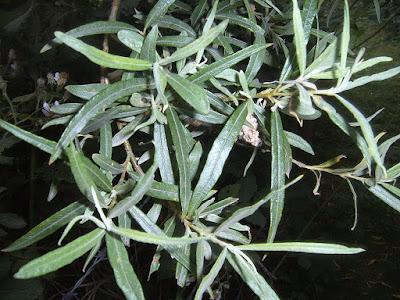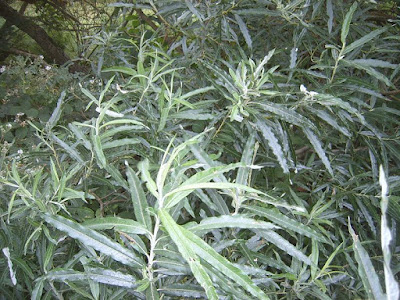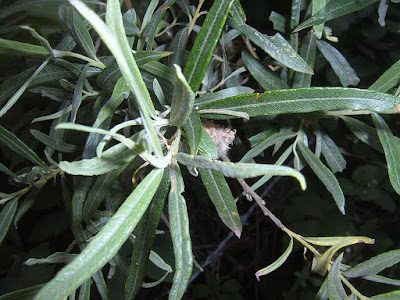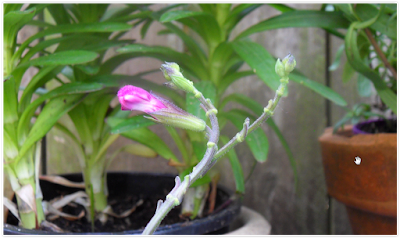Young Grey Willow plants are strange. They look nothing at like what they do when they get older. Look at the image below of a baby example in a pot. They grow flat and spread out across the pot. With some plants and trees you can instantly tell what they are. But with Grey Willow, they make a strange transformation at some point, where they take on their more older, more recognisable appearance. Also, I know Willow are known for rooting, and this species is no exception. Young Grey Willow roots like crazy.
And the growth rate is unbelievable. One day there's the start of a few new leaves, the next day they are fully sized and there's more new little leaves sprouting. I've never seen growth quite as fast as that. I'm not feeding them anything special. In fact I've only really fed them water. Some seed sellers market the Paulownia Tomentosa as one of the "Fastest Growing Trees".
I've grown Paulownia Tomentosa and I can tell you, this is nothing but a myth. In my experience they don't grow fast at all. They have nothing on Grey Willow. Can't wait for the one in the image to get more mature and see how it transforms. Since writing this post a few days ago it is now twice the size. I might update this blog at some point to show its progress. Weird magical Willow.
White Willow Tree Leaf Identification
White Willow (Salix alba) is a beautiful tree. Identification is easy. In some ways, with its long leaves, it looks quite oriental and not native to the UK. But that is not the case. It is native to the UK, as well as many other countries throughout Europe (And Asia). It's very decorative and have no doubt that it is widely used as a display specimen as a corner piece placed in expensive pots in trendy gardens. Or, grown in the ground of course.
Although some people are weary of growing Willow trees in the ground because the Root Systems of some species can be very aggressive. And sometimes, the roots can be seen at ground level or not much deeper. I believe the Weeping Willow definitely falls into this category. So this is something to be aware of, especially if you have a small garden, or are thinking of planting a Willow Tree very close to your home.
That's because the underside of the leaf is white / very light grey.
The bark has many medicinal properties, most of which are beneficial for providing pain relief for issues like menstrual cramps, headaches, osteoarthritis and gout. It's also known to be a skin exfoliant and is used in acne creams. Willow bark contains Salicin, which is anti-inflammatory and works much like an aspirin tablet. White Willow Tree extracts / tinctures and teas are widely available for sale online. And you can even make / harvest your own if you have the time and the patience to do so.
All in all, the White Willow Tree is a remarkable plant, and really demonstrates how natural herbs and remedies can be used to effectively treat certain ailments without the need to go rushing off to the pharmacy to buy treatments that are not made using natural processes.
Although some people are weary of growing Willow trees in the ground because the Root Systems of some species can be very aggressive. And sometimes, the roots can be seen at ground level or not much deeper. I believe the Weeping Willow definitely falls into this category. So this is something to be aware of, especially if you have a small garden, or are thinking of planting a Willow Tree very close to your home.
It's Green - Why is it called "White" Willow?
That's because the underside of the leaf is white / very light grey.
The bark has many medicinal properties, most of which are beneficial for providing pain relief for issues like menstrual cramps, headaches, osteoarthritis and gout. It's also known to be a skin exfoliant and is used in acne creams. Willow bark contains Salicin, which is anti-inflammatory and works much like an aspirin tablet. White Willow Tree extracts / tinctures and teas are widely available for sale online. And you can even make / harvest your own if you have the time and the patience to do so.
All in all, the White Willow Tree is a remarkable plant, and really demonstrates how natural herbs and remedies can be used to effectively treat certain ailments without the need to go rushing off to the pharmacy to buy treatments that are not made using natural processes.
Hound's Tongue - Cynoglossum Officinale
This is just a quick identification post about the Hound's Tongue Plant (Cynoglossum Officinale), which is part of the Borage species. Such a nice plant. Although it is potentially dangerous and considered as a weed to some. The flowers are purple / maroon and the leaves feel very soft to the touch. After the flowering period the Hound's Tongue bears nutlets (seeds).
However, I have not seen them much due to not having a lot to do with this plant. There's also Blue Hound's Tongue (Cynoglossum grande). And I think there are different variations of the purple Hounds Tongue as some examples from other parts of the world look quite different to each other. The picture below is of Hound's Tongue found in the UK (Quickly taken by me).
Be aware: Hound's Tongue can be poisonous to humans if eaten in big enough quantities, and can also cause dermatitis. It can also be lethal to animals / livestock. Not just a pretty face then! I better go wash my hands. Other than being an attractive plant, or noxious weed as some like to consider them, the best thing about these wildflowers is there smell. Though, it must be an acquired taste because a lot of people say it smells disgusting. Personally I like it. It's quite unique and very alluring. I believe you can buy the flower essence online.
However, I have not seen them much due to not having a lot to do with this plant. There's also Blue Hound's Tongue (Cynoglossum grande). And I think there are different variations of the purple Hounds Tongue as some examples from other parts of the world look quite different to each other. The picture below is of Hound's Tongue found in the UK (Quickly taken by me).
Be aware: Hound's Tongue can be poisonous to humans if eaten in big enough quantities, and can also cause dermatitis. It can also be lethal to animals / livestock. Not just a pretty face then! I better go wash my hands. Other than being an attractive plant, or noxious weed as some like to consider them, the best thing about these wildflowers is there smell. Though, it must be an acquired taste because a lot of people say it smells disgusting. Personally I like it. It's quite unique and very alluring. I believe you can buy the flower essence online.
Subscribe to:
Comments (Atom)
Trending
-
Looking at Elm and Beech (UK and American Beech) tree leaf images online, it's clear to see that they are fairly difficult to tell apart...
-
Alder trees ( Alnus Glutinosa ), with their attractive foliage, have quickly become one of my favourites. I love trees that are tough (UK h...
-
Spotted this Walnut Orb Weaver (Nuctenea umbratica) Spider just sitting on a house wall. It's a real beauty. This picture was taken in t...
-
Here is an image of a Coprinus Mushroom (Ink Cap). If you look closely at this picture you will see that the mushroom is actually melting / ...
-
Luminous, Illuminous, call it what you like, but wow, take a look at this spider I spotted that was just chilling on the leaf of a Grey Will...
-
Germinating Paulownia Tomentosa Seeds is a fairly easy process, and I'm sure there are many ways to germinate the seeds. The way I do i...










